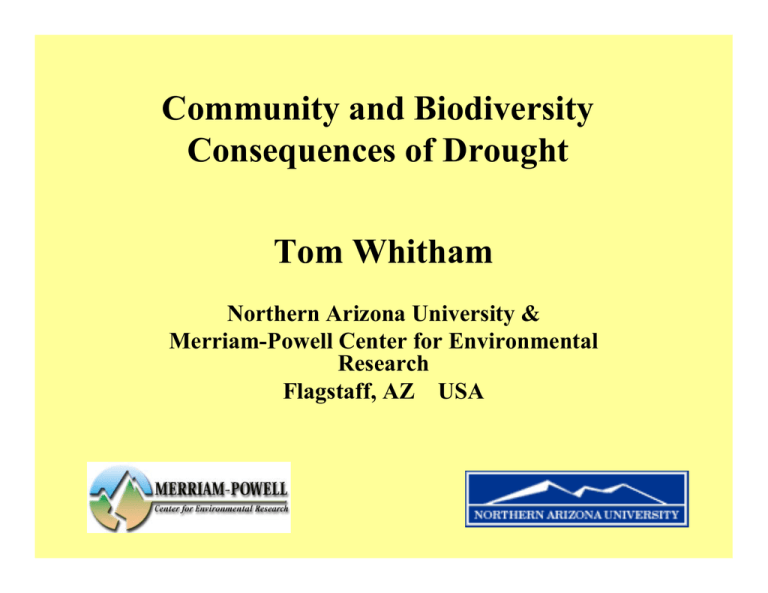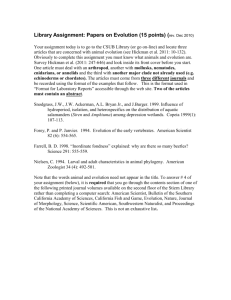Community and Biodiversity Consequences of Drought Tom Whitham Northern Arizona University &
advertisement

Community and Biodiversity Consequences of Drought Tom Whitham Northern Arizona University & Merriam-Powell Center for Environmental Research Flagstaff, AZ USA Pinyon mortality North side of the San Francisco Peaks, AZ Photo mosaic by Paul Heinrich taken December 2003 Key Questions 1. As the dominant plant suffer water stress and die during a record drought, how will the rest of the dependent community be affected? 2. Will all vegetation types be equally affected or is it just restricted to certain species like pinyon and ponderosa pine? 3. What are the management implications for preserving biodiversity? Mean Arthropod Richness / Tree On Trees Growing Under Low Stress 14 B High Stress Low Stress B 12 10 8 A A B 6 4 A 2 Mean Arthropod Abundance / Tree 0 1B: Overall Mean Arthopod Abundance Is Highest Figure Predators Parasites OnHerbivores Trees Growing Under Low Stress High Stress Low Stress 600 B 40 20 A In an arthropod community of 266 species, species richness is 2 X higher and abundance is 12 X higher in low stress sites than high stress sites. B A A B Trotter et al. 2004 0 Herbivores Predators Parasites Figure 2: Canopy Arthropod Community Composition Differs Significantly Between Trees Growing In High and Low Stress Changes Arthropod Communities Stress Environments 0.6 High Stress Sites 0.4 Y Axis 0.2 High Stress 1 High Stress 2 High Stress 3 Low Stress 1 Low Stress 2 Low Stress 3 0.0 -0.2 -0.4 -0.6 -0.6 Low Stress Sites -0.4 -0.2 0.0 X Axis 0.2 0.4 0.6 Trotter et al. 2004 Ectomycorrhizae on fine root of pinyon pine Environmental Stress Shifts Ectomycorrhizal Community O'Neill Crater RFLPs R = 0.652 P < 0.00001 Low Mortality Sites High Mortality Sites Swaty et al. 2004 Ecology Low Mortal High Morta Watering experiment conducted by Crescent Scudder to test for community release. May 23, 2003 Mean Athropod Abundance on Arthropod Non-watered vs Abundance Watered Pinyons 40 p=.028 30 Watered Pinyons Non-watered Pinyons 20 10 0 Watered Control Mean Arthropod Richness on Non-watered vs Watered Pinyons 20 Species Richness p=.031 Supplemental watering increases arthropod abundance and species richness. 15 10 Scudder unpub. data 5 0 Watered Control Low Stress High Stress Plant stress affects arthropod and microbial communities differently. Ring width expansion (mm) 2.0 a a Tree ring widths 1.5 Climatic stress negatively affects pinyon growth. b b 1.0 c c d d 0.5 d d 0.0 % Ectomycorrhizal Colonization 100 Mycorrhizal abundance 80 c 60 40 b a a Mycorrhizal mutualists increase with intermediate stress, but decline at high stress levels. a 20 0 1 Low 2 3 4 Tree Rank Stress Level 5 High Swaty et al. 2004 Ecology Tree Rings Predict Arthropod Species Richness 30% Richness vs. Ave 97-01 40 Species Richness per Tree Y Data 30 20 10 0 0 500 1000 1500 2000 2500 X Data Average Tree Ring Width 1997-2001 Ave 97-01 vs 30% Richness Plot 1 Regr Adrian Stone unpub. data 3000 Moth Resistant Pinyon These phenotypes are genetically based and have extended phenotypes that have community consequences. Susceptible Pinyon Photo by Tom Whitham Moth Resistant Tree 3X More Lilkely to Die During 2002 Drought Than Moth Susceptible Trees 80 % mortality 70 60 50 40 30 20 10 0 Moth Resistant Pinyons Stulz et al. unpub. data Moth Susceptible Pinyons The extended phenotypes of moth resistant and susceptible trees affect a diverse community of about 1000 species. Whitham et al. 2003 Ecology Drought impacts on dominant plants will negatively affect their dependent communities. Photos by Tom Whitham & Alicyn Gitlin Trees like cottonwoods should be of special concern due to low coverage. Gitlin et al. unpub. data Landscape coverage (%) Population mortality (%) Mortality of dominant plants at 20 randomly selected sites for each species within a 80km radius of Flagstaff. 50 P = <0.0001 40 30 20 10 20 0 15 10 5 0 Juni. Pond. Asp. Cotton. Manz. Pin. Dominant plant species Summary 1. Through its effects on community drivers (i.e., dominant and keystone species), drought negatively affects biodiversity. 2. Arthropod and mycorrhizal mutualist communities are negatively affected by extreme drought, but differ in their community responses at low stress levels. 3. Unexpected outcomes are likely (e.g., insect resistant trees are more likely to die). 4. Extreme drought is a bottleneck event that is also an evolutionary event. Mistletoe (Phoradendron juniperinum) on One-Seed Juniper (Juniperus monosperma) As a two-way interaction, a classic example of a parasite-host interaction Juniper and Mistletoe Share a Common Avian Seed Dispersal Agent Stands with mistletoe support 2x more seed dispersing birds Stands with mistletoe have 4x more juniper seedlings van Ommeren & Whitham 2002 Oecologia Scales associated with reversals • • • • Number of species Time Spatial scales Any mix of above Interactions Increase With the Addition of Factors % of Significant Interaction Terms 100 Observed Total Observed Significant Interactions Observed ObservedReversals Reversals 80 60 40 20 0 0 1 2 3 4 Number of Statistical Factors (Species, Time, Space) # of Statistical Factors Bailey & Whitham 2003 Management & Research Issues 1. In the absence of long-term community-level studies, fundamental errors in interpretation are likely due to the high probability of reversals. Need to support such studies to minimize these errors. 2. Need to minimize human impacts that exacerbate the effects of drought. 3. Need special emphasis on rare habitat types that are especially sensitive to drought (e.g., riparian habitat and springs). 4. Marginal or edge habitats that suffer chronic stress can be barometers of change and may be crucial to preserve as sources of extreme genotypes that may be best adapted to changing environments. << FHM Working Group Agenda




